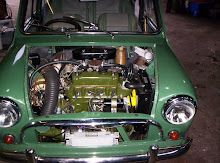It is best to decarbonize the combustion chambers before removing the valves, as there will then be no risk of damaging the valve seatings. Every trace of carbon should be scraped off and the surfaces should then be burnished with a wire brush; a cup-shaped brush, used in the chuck of an electric drill, is ideal for this job but patient hand work will give equally good results.
The mating faces of the head should also be cleaned, taking particular care not to score them. The valves can then be removed. The best tool to use to compress the valve springs is the official service compressor. The spring caps are retained by split-cone cotters which are in turn retained by small spring clips.
Discard the valve springs if, as recommended earlier, a new set is to be fitted. Otherwise stand them in line on a level surface and renew any that are noticeably shorter than the others or which have distorted coils.
Removing a valve-retaining cotter: 1, quick-action valve-spring compressor; 2, split-cone cotter
As each valve is withdrawn from its guide it should be placed in the correct order on the bench. The valves should not be interchanged. It is a good plan to drill holes in a length of wood to take the stems and to number these to correspond with the positions in the head.
The undersides of the valve heads, the stems and the ports in the head, which could not be reached when the valves were in position, should now be thoroughly cleaned. Care must be taken not to score the seatings on the valves and in the combustion chambers.
The valve stems should be scraped clean. Emery cloth should not be used on the lengths that work in the guides. The guides themselves should be cleaned out by drawing a paraffin-soaked rag through them. Each valve should then be checked for fit in its own guide. Any noticeable degree of sideways shake indicates the need for new valves and guides; the best plan is to take the head to an Austin or Morris dealer for advice and, if he confirms the diagnosis, to allow him to fit new guides and to re-cut the seatings in the head.
Similarly, if the seatings on the valves and in the cylinder head are badly pitted, they must be re-cut with special abrasive stones and the
The method of assembling the valve components
valve faces trued-up in a suitable machine. Excessive grinding-in, in an attempt to remove deep pitting, results in recessed seatings and incorrect mating angles which cause loss of power. It is then necessary to cut the seatings first with a 15° cutter, to narrow them, followed by the normal 45° cutter.




0 comments:
Post a Comment